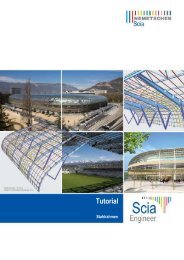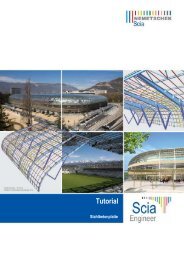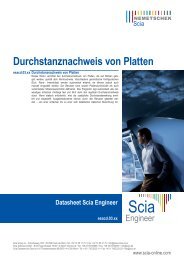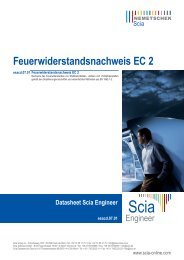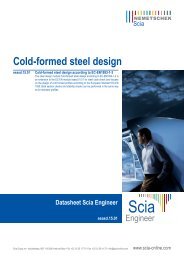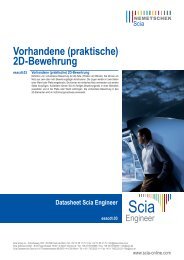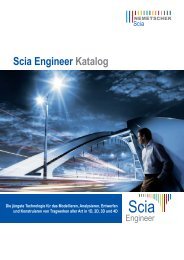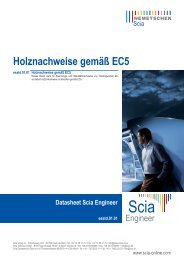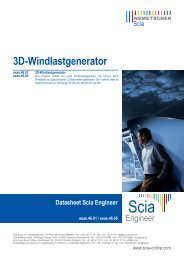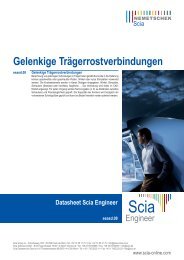Advanced Package Training Scaffolding 2011.1 - Scia-Software GbR
Advanced Package Training Scaffolding 2011.1 - Scia-Software GbR
Advanced Package Training Scaffolding 2011.1 - Scia-Software GbR
You also want an ePaper? Increase the reach of your titles
YUMPU automatically turns print PDFs into web optimized ePapers that Google loves.
Working wind load<br />
14<br />
<strong>Advanced</strong> <strong>Training</strong><br />
A uniformly distributed velocity pressure of 0,2 kN/m² is taken into account.<br />
To make allowance for equipment or materials which are on the working area, a nominal reference<br />
area is assumed. This area is 400mm and includes the height of the toeboard. (En 12811-1, 6.2.7.4.2)<br />
Area of wind loading<br />
The wind load is inputted as an area load. The amount of this load, depends on the amount of the<br />
loaded area itself, so without cladding a smaller wind load will be inserted than with cladding or netting.<br />
Principle of combinations<br />
Following EN 12811-1, 6.2.9.2 the load cases have to be combined in two different ways: the service<br />
condition and the out of service condition<br />
In each individual case the service condition and the out of service condition shall be considered.<br />
a) The service condition consists of:<br />
1) The self weight of the scaffold<br />
2) Uniformly distributed service load (EN 12811-1, Table 3, q1) acting on the working area of<br />
the most unfavourable decked level<br />
3) 50 % of the load specified in a)2) shall be taken to act on the working area at the next level<br />
above or below if a working scaffold has more than one decked level.<br />
4) Working wind load<br />
b) The out of service condition consists of:<br />
1) The self weight of the scaffold<br />
2) A percentage of the uniformly distributed service load (EN 12811-1, Table 3, q1) acting on<br />
the working area of the most unfavourable decked level. The value depends on the class:<br />
Class 1: 0% (no service load on the working area)<br />
Classes 2 and 3: 25% (representing some stored materials on the working area)<br />
Classes 4, 5 and 6: 50% (representing some stored materials on the working area)<br />
3) The maximum wind load<br />
In cases a)2) and b)2), the load shall be taken as zero, if its consideration leads to more favourable<br />
results.<br />
Load cases in <strong>Scia</strong> Engineer<br />
The following load cases will be inputted in <strong>Scia</strong> Engineer:



